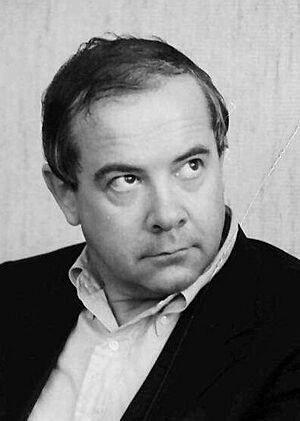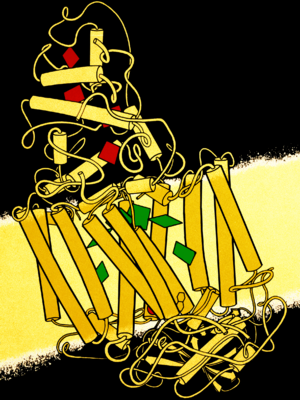Johann Deisenhofer facts for kids
Quick facts for kids
Johann Deisenhofer
|
|
|---|---|
 |
|
| Born | September 30, 1943 Zusamaltheim, Germany
|
| Citizenship | Germany and United States |
| Alma mater |
|
| Known for | |
| Awards | Max Delbruck Prize (1986) Golden Plate Award of the American Academy of Achievement (1989) Nobel Prize for Chemistry) (1988) |
| Scientific career | |
| Fields | Biophysics and biochemistry |
| Institutions | University of Texas Southwestern Medical Center |
| Doctoral advisor | Robert Huber |
Johann Deisenhofer was born on September 30, 1943, in Germany. He is a German biochemist, a scientist who studies the chemistry of living things. In 1988, he won the famous Nobel Prize for Chemistry. He shared this award with two other scientists, Hartmut Michel and Robert Huber. They earned the prize for discovering the exact structure of a special protein. This protein is found in cell membranes and is vital for photosynthesis. Photosynthesis is how plants and some bacteria turn sunlight into energy.
Contents
Early Life and Education
Johann Deisenhofer grew up in Bavaria, a region in Germany. He went to the Technical University of Munich for his studies. In 1974, he earned his doctorate degree from this university. His research work was done at the Max Planck Institute of Biochemistry in Martinsried, West Germany.
He continued to work as a researcher at the Max Planck Institute until 1988. After that, he moved to the United States. He joined the scientific team at the Howard Hughes Medical Institute. He also became a professor in the Department of Biochemistry at The University of Texas Southwestern Medical Center at Dallas.
Discovering Protein Structures
Johann Deisenhofer, along with Hartmut Michel and Robert Huber, made a huge discovery. They figured out the 3D shape of a special protein complex. This complex is found in certain types of bacteria that perform photosynthesis. This specific protein complex is called a photosynthetic reaction center. Scientists already knew it was very important for starting a simple kind of photosynthesis.
Using X-ray Crystallography
Between 1982 and 1985, these three scientists used a method called X-ray crystallography. This technique helps scientists see the exact arrangement of atoms in a crystal. They used it to map out the more than 10,000 atoms that make up the protein complex. Their detailed research helped everyone better understand how photosynthesis works. It also showed that the way plants and bacteria do photosynthesis is quite similar.
Current Work and Contributions
Today, Johann Deisenhofer is a professor. He teaches in the Department of Biophysics at the University of Texas Southwestern Medical Center. He also helps guide an organization called Scientists and Engineers for America. This group works to make sure that science is used wisely in the American government. In 2003, he was one of many Nobel Prize winners who signed the Humanist Manifesto. This document shares ideas about human values and reason.
See also
 In Spanish: Johann Deisenhofer para niños
In Spanish: Johann Deisenhofer para niños


